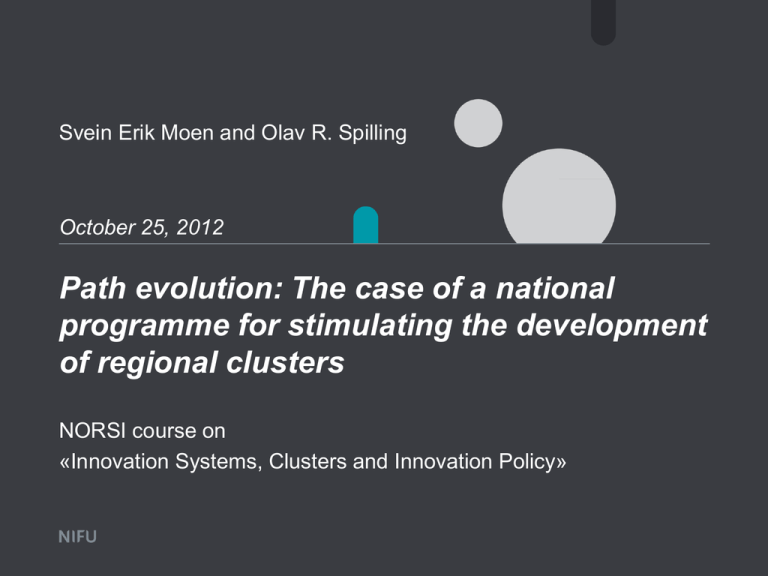Spilling 2 - BI Norwegian Business School
advertisement

Svein Erik Moen and Olav R. Spilling October 25, 2012 Path evolution: The case of a national programme for stimulating the development of regional clusters NORSI course on «Innovation Systems, Clusters and Innovation Policy» Path evolution: The case of a national programme for stimulating the development of regional clusters Structure Cluster programmes in Norway The Arena Programme Framework for analysing path evolution Cases: 1. Fish farming technology 2. Health and welfare technology 3. Information security technology Classification of all Arena projects Reflection around the role of the Arena Programme 2 Cluster programmes in Norway Norwegian Centres of Expertise (NCE) Addressing clusters consisting of world class enterprises in their field. 12 clusters representing well established and well performing networks of firms with a significant potential for further development The ARENA Programme Addressing groups and networks of firms not yet developed as clusters, but with a potential to do so Currently 28 projects operating, representing at variety of emerging cluster 3 Mostly based on well established industries, technology oriented, with a long history, but partly moving into new areas. One addressing the tourism industry Three projects addressing ‘new’ technological fields: - Instrumentation - Culinology - Energy Trading Arena June 2012 The Arena Programme A business cluster programme which offers financial and advisory support for the organisations and strategic development of potential (regional) business clusters. – 70 projects have so far been supported (2002-2012) A variety of sectors and technologies: – Offshore, – Aquaculture – Materials science – ICT sectors – Environmentally friendly technologies – Electric mobility technology – Pharmaceutical technology, health and welfare technology – Water technology – Tourism, cultural industries, events – Media technology Endres i topp-/bunntekst 01-02-03 6 The Arena Programme (cont.) Main goal: Strengthen the regional business environment’s capability for innovation and value creation Addressing groups or networks of businesses with a potential for developing as clusters and increased value creation. The groups should be based on collaboration between companies and knowledge institutions (universities/research institutes) The programme is stimulating new and untraditional combinations of networks of actors Based on annual calls, the most promising business groups are invited to participate in the programme for three years The programme is organised in collaboration between the tree main innovation agencies (IN, SIVA and RCN) 7 Two what extent do the Arena projects contribute to innovation in the Norwegian economy? How can we determine the degree of novelty and innovation potential of the Arena clusters? Secondary data: Evaluation reports of the programme as a whole Plans and annual reports for the individual projects Evaluation reports for finished projects In addition: Discussions with the program managers Endres i topp-/bunntekst 01-02-03 8 The path evolution framework: What is ‘new’? Marginal changes The development goes on mostly based on business as usual Radical changes Emergence of completely new industries and technologies not related to existing industries Three forms of path evolution 1. Path extension: Further development of existing industries and clusters based on existing technologies and knowledge bases. 2. Path renewal: Development based on existing industries and cluster, but in related areas (branching). 3. Path creation: Development based on new technologies and new organisations in new industries. (Based on Tödtling and Trippl 2011; Aasheim et al; 2012) 9 The path evolution framework: Key factors We apply the following factors for determining the relative novelty of an emerging business cluster: – Actors and networks (what type of actors are involved?) – Value chains (producers, users and suppliers of products and services) – Activities (what kind og activities are organised in the new cluster) – Products/services (new or traditional?) – Markets (new or existing?) – Technologies and knowledge bases 10 The path evolution framework: Categories Path extension: - Upgrading or revitalisation of the businesses - Limited elements of novelty as a strategy for maintaining competitiveness - Building on well-known technologies and knowledge in mature or established sectors in the national system. Path renewal - New development of business activities in areas related to the existing industries and cluster, - The knowledge base does not change radically, but is developed towards areas of relevance to the new development - In the long run, changes of path renewal may become substantial for the national innovation system. Path creation - The project represent a potentially new industrial path - New industries based on new technologies and new organisations are emerging, - A new knowledge base is gradually developing. 11 Case 1: Fish farming technology Actors and networks Activities Products/ services Technologies and knowledge Market Value chain Established actors in a traditional industry Well established relations between firms, R&D institutes and universities. Technological development and increased innovation collaboration between the actors in the existing value chain Technologies for sustainable fish farming Traditional fish farming technology in combination with new technologies and knowledge about sustainability The existing market for fish farming technology Developed during the 1970s, is now well established Classification Path extension. Most of the factors are already well developed and integrated parts of the national innovation system. 12 Case 2: Health and welfare technology Actors and networks Activities Products/ services Technologies and knowledge Market Value chain Classification Partly new constellation of actors (industrial actors; consultancies, public sector (hospital), university college) Some of the actors with little or no sector specific experience. Collaboration in network activities focused on research, development and sale of welfare technologies. Building up a new marketing and sales organisation New products and solutions (technological assistance) for the health sector Knowledge about health care and welfare technologies (assistive technologies, ICT systems and medical technology) Growing (new?) market for health care technologies in the public and private market (home and community care) Partly old and new value chain Path renewal. Some factors are new, but they represent branching from an existing industrial path into new industries. 13 Case 3: Information security technology Actors and networks Activities New constellation of actors: Suppliers of products and services within information security ; R&D-institutes; University college The creation of a national network for information security. Competence building, R&D and technological development Collaboration in a new industrial area. Increase public awareness of information security Stimulate start-ups in the area Nes ICT-based solutions for the information security sector Products/ services Technologies Partly existing knowledge developed at military research labs in and combination with new knowledge and ICT knowledge Market New and emerging market for information security within the ICT-sector Value chain Potential for developing a new value chain Classification Path creation. Potentially a new industry based on new value chains 14 Summary of cases Actors and networks Activities Products/ services Technologies and knowledge Market Value chain Classification Fish farming technology Existing actors Improved networks More focus on innovation Fish farming technology Well established technology and knowledge base Existing market for fish farming technology Existing Path extension Health sector technology New combination of actors, new networks New products and services, new sales organisation Health and welfare technology and services Existing technologies in new combinations Emerging markets for new products and services Partly new Path renewal Information security technology New constellation of actors, new networks R&D and competence development, Focus on start-ups ICT-based information security services Existing knowledge base in combination with new technologies Emerging marked within the information security field Potentially new value chain Path creation 15 Classification of all the Arena projects Preliminary classification of 70 projects – classification based on the intentions and objectives for the projects (not obtained results): – Path extension: 35 – Path renewal: 32 – Path creation: 3 The programme to a little extent stimulates radical innovations and the development of new industries. How can this be explained? 16 Arena’s objectives Main objective: focus on value creation, not innovation per se: Originally (2002): Contribute to more value creation in regionally based businesses/industries by strengthening the interaction between industrial actors, knowledge institutions and public actors Later (from 2006): Contribute to develop regionally based industrial milieus towards more innovation and value creation by strengthening ... Targets: Increased internal interaction between the project participant Increased external interaction with external actors (at the national and international level) More innovative and cooperative firms More focus on businesses and industrial development in R&D-institutions and educational institutions 17 Selection criteria The resource base of the project (i.e. the resources of the participating actors) The network/relations between the actors Project quality - Objectives - Strategies - Plans - Embeddedness Other criteria (specific for the individual calls) Project quality; in particular project management 18 Evolutionary processes and the role of ARENA Basic processes of evolution ARENA services ARENA Mobilisation/ Proposals Information Guiding potential projects Selection Selection/ Pilot projects/ Main projects Supervicing project managers Competence services Retention Additional funding/ Exit (Struggle/Growth) (Further development after Arena) Variation The selection processes of Arena Path extension projects: – Face the lowest barriers for developing and organising the projects – Most factors are well-known, there is an established practice for organising innovation activities – Networks among the relevant actors are fairly well developed. Path renewal projects – The degree of novelty is somewhat higher – But the projects will be organised in the context of elements that are fairly well known Path creation projects: – Call for more radical changes – Barriers for organising may be very high – Challenging to involve a critical mass of committed actors. Endres i topp-/bunntekst 01-02-03 20 Concluding remarks Low level of path creation seems reasonable: Given the main objective of stimulating more value creation Given the lower barriers of organising path extension and path renewal projects Given the current situation in Norway of positive lock-in in resource based sectors Higher risks of failure for path creation projects However (issues for analyses): What is the optimum balance between path extention/renewal and creation projects? Should the program to a higher extent stimulate path creation projects? What would be the implication in terms of programme organisation? 21 Thanks for your attention! olav.spilling@nifu.no www.nifu.no






